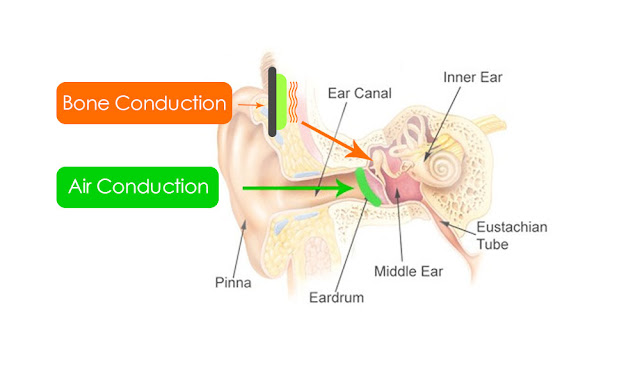Apple has been working on a technology called Bone-conduction technology and recently filed a patent with the title “Multipath audio stimulation using audio compressors”.
 |
| Image source: Google |
Conduction and types of conduction:
If a medium is capable of transmitting sound, then it is
called a sound conductor. The most common conductor we rely upon is air. When a
sound is generated from a source, it vibrates the air. When these vibrations
are sensed by human ear, the human brain analyses it and we then feel the
sound. This is called Air-conduction, as air is the medium carrying the sound vibrations.
Through Bone-conduction technology, a user can hear the sound vibrations
through the user’s cranium i.e., the skull. In contrast with that of the air-conduction,
bone-conduction allows the sound vibrations to be transmitted directly through
the user’s body.
 |
| Air-conduction and Bone-conduction Image source: Wiki |
Working of Bone-conduction AirPods:
Though Apple is calling them bone-conduction AirPods, they
don’t rely completely upon bone-conduction. These AirPods filter the input
audio to a high-frequency component and a low-frequency component. A
low-frequency compressor is configured to reduce dynamic range of the
low-frequency component and an air-conduction transducer is configured such
that it converts the high-frequency components into air-vibrations so that
these vibrations can be sense by the user. Finally, a bone-conduction
transducer is setup to convert the low-frequency component with reduced dynamic
range into vibrations in the cranial bone.
 |
| Components of bone-conduction explained in Apple's patent document |
The bone-conduction AirPods can produce sound vibrations based
up on the portion of the cranium through which the sound is being transmitted.
For example, vibrations created by the AirPods through the temporal bones that
produces a different sound experience to the user. Sound vibrations can be
transmitted through the other parts of the cranium like the nasal bone, sphenoid
bone or the jaw bone.
Every technology comes with its own pros and cons. The
technology succeeds only if it can over come the most common cons. However,
here are the pros and cons of the bone-conduction technology.
Pros of bone-conduction technology:
- As the vibrations are sensed through bones rather than air, the user still be able to listen to the external sound even with the AirPods in place.
- Bone-conduction helps people with hearing impairment to grab the most advantage to hear the sounds.
- This technology is particularly useful where air-conduction is not possible, may be in space.
Cons of bone-conduction technology:
- This technology doesn’t work fine for high-frequencies, as humans can hear only a range of 20Hz to 20kHz frequencies.
- As the sound vibrations are transmitted through the bones, high intensity sounds may cause tickling to some times annoying range of vibrations.
Though there are chances that Apple may implement this
technology on its smartglasses but AirPods are more likely to get this
technology to get into the market. There are various other speculations like Apple
is working on hear impaired project. Unless Apple declares, all of these
speculations keep mushrooming!
You can find the patent submitted by Apple here.










0 comments:
Post a Comment